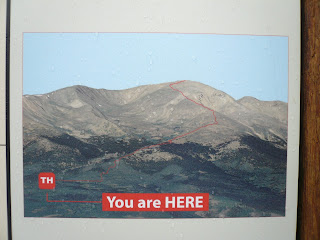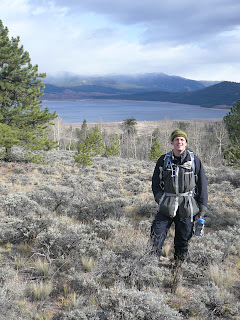Mount Elbert - A New Level of Challenge
Twin Lakes, CO
10/13/12
13 miles, 7.5 hours
84 days to Africa
If you ever want to know what your butt looks like once it has been handed back to you, Mount Elbert is a great place to go find out. Deb and Greg made a trek out to the beautiful State of Colorado to officially make a bid to become "14'ers", which is the term commonly given to individuals who manage to hike up to 14,000 feet. The theory behind the trip was that it would be great to get some experience hiking at an elevation that is clearly higher than anything available in Minnesota. The process of testing that theory was both rewarding and challenging. The results of the test were mixed, and included a healthy respect for mother nature, a sense of slight disappointment, and an overall feeling of satisfaction and a firm belief that we are heading in the right direction with our training.
First off, we did not make it to the summit of Mount Elbert. The mountain's peek is 14,333 feet and we maxed out somewhere in the vicinity of 14,100 feet. It was agonizing to come so close to the top of the mountain only to turn around and head back down, but the experience gave us a great chance to exercise the adage that it is best to live to hike another day than to die or get injured attempting to reach the peak. The context for our decision to turn around rather than press forward were 30-40 mile per hour winds (with gusts that may have exceeded that) and an unpleasant sleet/snow mix that traveled horizontally into our faces and backs as we trudged forward towards the summit. The conditions themselves were not ideal, but the truly frightening factor that ultimately led to the decision to turn around was the near whiteout conditions that would occur when the wind and the snow acted in unison to essentially mask the trail we had just climbed up. The wind was blowing so hard that our foot prints were quickly erased in the thin layer of snow that clung to the mountain top, and the only guide posts that remained were a series of four deep ruts that have been carved over the years by hikers and a large boulder that sat firmly at the edge of the trail about 500 hundred yards below where we ended up turning around. Needless to say, it is a bit unnerving to look behind oneself and have to guess where exactly you think you last saw the path you just hiked up. Fortunately, the whiteout conditions were not continuous and, with minimal difficulty, we were able to find our way back to the large boulder that served as a guide post. From there, the trail became much clearer.
We have read, and heard, enough at this point to not have any delusions that our hiking at 14,000 feet will in any real way compare to hiking at 17,000 or 19,000 feet on Kilimanjaro. The word on the "hiking community street" is that the elevations 15,000 and above are when oxygen levels become even more limited in supply, and that some of the more serious side effects from the altitude are experienced.
What is comforting, however, is the fact that both Deb and Greg were able to hike at 14,000 feet without feeling any significant altitude or physical effects, such as nausea, dizziness, or headache. Deb reported feeling as though she had someone standing on her chest, and Greg reported a very slight nauseous feeling a few times when he would start to hiking again after taking a short break. But, neither of us felt that either condition was prohibitive to our moving forward. What was surprising was how hard our bodies were working without some of the more common signs we would have expected. Each time we would stop for a break, we could hear our hearts thumping. However, neither of us had the sensation that our hearts were working that hard as we climbed.
What proved to be an effective strategy was to set miniature goals and allow ourselves time for a brief break upon achieving the goal. Deb took the lead on the hike while Greg played pack mule and carried with him a slightly heavier pack load, including an HD video camera and some hiking rations to maintain our strength. Deb set small and achievable goals as she hiked. She would select a point ahead of herself and then push herself to make it to that area before allowing herself a break. Greg, meanwhile, labored behind working hard to achieve his own goal of making it to Deb's location. He would then stand there long enough to allow his heart to calm down a bit. Deb's determination shone through and was truly inspirational.
The hike back down presented its own challenges. On the way up, we made every effort to avoid snow drifts in the trail as they made hiking more difficult. However, when going down we tended to stay in as deep of snow as possible because it provided some cushion and relief on our legs as we went down such a steep grade. The descent was also much less taxing on our lungs and hearts, but it placed a higher emphasis on our quadricep muscles than the hike up the mountain did.
The hike back down presented its own challenges. On the way up, we made every effort to avoid snow drifts in the trail as they made hiking more difficult. However, when going down we tended to stay in as deep of snow as possible because it provided some cushion and relief on our legs as we went down such a steep grade. The descent was also much less taxing on our lungs and hearts, but it placed a higher emphasis on our quadricep muscles than the hike up the mountain did.
Regardless of the direction of travel, the scenery was awe inspiring. It was a great challenge to look ahead and consider that in a matter of hours we would be traveling from the relative comfort of the lowlands of 9,500 to 10,000 feet into the snow covered summit at 14,000 feet. It was also extremely welcoming to descend into familiar territory, warmer temperatures and reduced winds as we made our way back down.
If the goal was to summit the mountain, Mount Elbert won the battle. If our goal was to get a better sense for the types of conditions we may experience on Mount Kilimanjaro and to gauge our bodies' response to those conditions, then we are much better prepared for the next battle. We are comforted by the fact that it was our own safety that pushed us off the mountain rather than our physical limitations. That said, it should be noted that both Deb and Greg were more than happy to indulge in a nap upon returning to our quarters, followed by a great homemade dinner and then an early bed time. What will it be like to end a similar day of hiking with the reward of sleeping in a sleeping bag on the ground in a tent versus a relatively comfortable bed? We are guessing that time will tell when we begin our climb of Mount Kilimanjaro.
We left Colorado as "14'ers", who have a great appreciation for the challenge that lies ahead for us. We are invigorated by the experience and will take the lessons we learned from Mount Elbert forward with us as we continue to train for the Kilimanjaro challenge.












No comments:
Post a Comment